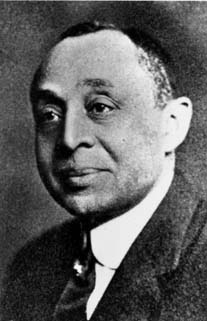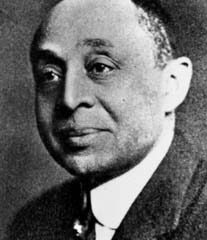Black History
Garnet Douglass Baltimore

A Profile in Black History
by Suzanne Spellen
We shouldn’t have to wait for Black History Month to highlight important men and women who made American history. Today, I’d like to introduce you to a great man and his family who lived in Troy, NY.
Garnet Douglass Baltimore is Troy, NY’s most well-known African American citizen. There is certainly good reason for that – he was born and raised here and during his lifetime accomplished great things in this city. His accomplishments can be seen around us today, even though he was active at the turn of the 20th century and died almost 80 years ago.
He was a man of many “firsts.” In his business and social life, he was not just a “first,” he was an “only,” up until the end of the 20th century and beyond. One of the things that he wasn’t was a diarist, or someone who spoke much about himself in print or otherwise. So, while we know of the man and his deeds, we still really don’t know him. He remains an enigma. I hope to be able to someday fill in some blanks. But in the meantime – here is his inspiring story, and for that, we have to start sometime before his own beginning.
Baltimore was born in Troy, NY, that small city just upriver from the state capital of Albany. Once part of the patroon (feudal lands) of 17th-century diamond merchant and Dutch West India Company co-founder Killian Van Rensselaer, the village of Troy was established in 1787. Because of its location on the Hudson River, Troy initially developed as a trading town, a nexus point between Boston and New England to the east, Canada to the north, western NY and the Great Lakes to the west and the Hudson River towns and New York City and its harbors to the south.
As the 19th century progressed, Troy became an industrial center, as an abundance of fast flowing water feeding into the Hudson from two creeks that run through the city, became home to textile, paper and other mills, and most importantly, a large and important iron industry. Troy was an educational hub as well, with important schools, including Rensselaer Polytechnic Institute(RPI), the oldest technical college in the country. It was founded in 1824 by Stephen Van Rensselaer, Killian’s descendant.
Around the time Stephen Van Rensselaer was establishing his institution, a woman named Hannah Lord Montague invented a detachable collar for her husband’s shirts. The idea took off like wildfire. By the time Garnet Baltimore was born, in 1859, Troy was a rich city, prospering from its position on the Erie Canal, from iron and steel, its educational institutions and from the manufacture of millions of detachable, starched and pressed shirt collars.
Garnet’s family saw Troy’s beginnings. His grandparents, Samuel and Phebe Baltimore were free people of color who came to Troy in the early 1800s. They, like many others, came west from New England. Samuel and his wife ran a popular seafood restaurant. Their youngest child was Peter F. Baltimore, Garnet’s father.
The Capital Region had a small but established black population in the mid-1800s. But even though they enjoyed relative peace and success, no one could be truly free while slavery existed in America. Fighting slavery was not just a moral decision for many, it was a duty. Troy’s black Abolitionists were joined with those in Albany and the surrounding region.
This now-famed Abolitionist Henry Highland Garnet came to Troy in 1840 and was named the pastor of Troy’s Liberty St. Presbyterian Church for Colored People. From his pulpit, Garnet honed his skills as an orator, and was renowned for his inspiring speeches on freedom, equal rights and temperance. He became a mentor to Peter Baltimore, a teenager in those early years, and Peter often accompanied him to NYC and elsewhere for speaking engagements. Troy’s anti-slavery activities would grow in the years to come, especially after the Fugitive Slave Law was passed in 1850, allowing slave catchers to come north to capture escapees, and making it illegal for anyone to help in their escape.
Peter became a barber and established an upscale “tonsorial resort” called the Veranda. His emporium was popular with Troy’s wealthy movers and shakers and was known as a place where they could be expertly groomed while relaxing with their peers, engaging in discussions of the day, with Peter as a knowledgeable, popular and gregarious host. What none of his customers knew was that the Veranda was a major stop on the Underground Railroad. Many of those quietly sweeping up or working in the shop or the hotel next door were escapees, bound for Canada. Baltimore was hiding them in plain sight.
Baltimore’s anti-slavery activities and his friendship with Rev. Garnet brought him into contact and friendship with Harriet Tubman, who had a cousin living in Troy, as well as with Frederick Douglass and other Abolitionists who spoke in Troy. When his youngest son was born, Peter and his wife Caroline named him for the family heroes – Garnet Douglass Baltimore.
Garnet was a child during the Civil War. He and his brother were educated at the William Rich School for Colored Children, founded by another successful black barber with a wealthy white clientele, who was also an active Abolitionist along with Garnet’s father. Troy may have been proud of its anti-slavery stance and activities, but the schools were still segregated. The Rich school was the city’s black school.
The school started out with black teachers and administrators, but by 1872, it was being run by a white minister who told his students that they shouldn’t aim too high, as they were fit only for lesser positions. Undeterred, Garnet and his brother were urged by their parents to apply to the prestigious Troy Academy, the school for the city’s rich boys. It had never had a black student. But they soon would, as both boys were admitted, becoming the first African American students in the school’s history. Garnet studied there for five years, intending to go to Harvard.
But in 1877, he decided that he was more interested in mathematics and science than classical studies, and applied for admission to RPI, located not far from his family home. He was accepted, and in 1877, joined the 44 members of his class as the first African American student at the school. He graduated in 1881 at the top of his class, excelling in math, surveying and drawing, all tools needed by a civil engineer.
Continued next week.



